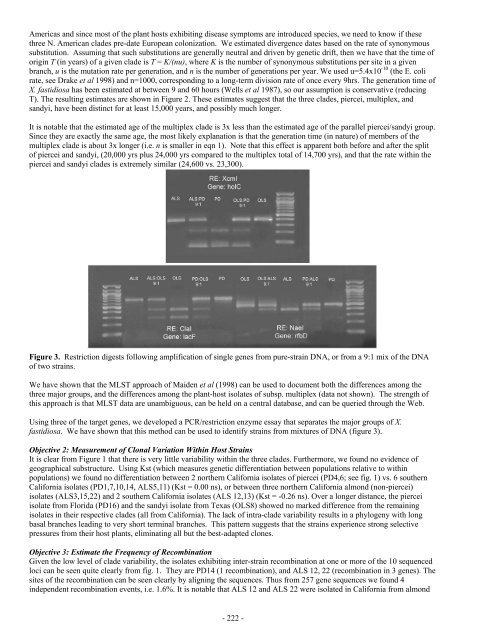Impact Of Host Plant Xylem Fluid On Xylella Fastidiosa Multiplication ...
Impact Of Host Plant Xylem Fluid On Xylella Fastidiosa Multiplication ...
Impact Of Host Plant Xylem Fluid On Xylella Fastidiosa Multiplication ...
Create successful ePaper yourself
Turn your PDF publications into a flip-book with our unique Google optimized e-Paper software.
Americas and since most of the plant hosts exhibiting disease symptoms are introduced species, we need to know if these<br />
three N. American clades pre-date European colonization. We estimated divergence dates based on the rate of synonymous<br />
substitution. Assuming that such substitutions are generally neutral and driven by genetic drift, then we have that the time of<br />
origin T (in years) of a given clade is T = K/(nu), where K is the number of synonymous substitutions per site in a given<br />
branch, u is the mutation rate per generation, and n is the number of generations per year. We used u=5.4x10 -10 (the E. coli<br />
rate, see Drake et al 1998) and n=1000, corresponding to a long-term division rate of once every 9hrs. The generation time of<br />
X. fastidiosa has been estimated at between 9 and 60 hours (Wells et al 1987), so our assumption is conservative (reducing<br />
T). The resulting estimates are shown in Figure 2. These estimates suggest that the three clades, piercei, multiplex, and<br />
sandyi, have been distinct for at least 15,000 years, and possibly much longer.<br />
It is notable that the estimated age of the multiplex clade is 3x less than the estimated age of the parallel piercei/sandyi group.<br />
Since they are exactly the same age, the most likely explanation is that the generation time (in nature) of members of the<br />
multiplex clade is about 3x longer (i.e. n is smaller in eqn 1). Note that this effect is apparent both before and after the split<br />
of piercei and sandyi, (20,000 yrs plus 24,000 yrs compared to the multiplex total of 14,700 yrs), and that the rate within the<br />
piercei and sandyi clades is extremely similar (24,600 vs. 23,300).<br />
Figure 3. Restriction digests following amplification of single genes from pure-strain DNA, or from a 9:1 mix of the DNA<br />
of two strains.<br />
We have shown that the MLST approach of Maiden et al (1998) can be used to document both the differences among the<br />
three major groups, and the differences among the plant-host isolates of subsp. multiplex (data not shown). The strength of<br />
this approach is that MLST data are unambiguous, can be held on a central database, and can be queried through the Web.<br />
Using three of the target genes, we developed a PCR/restriction enzyme essay that separates the major groups of X.<br />
fastidiosa. We have shown that this method can be used to identify strains from mixtures of DNA (figure 3).<br />
Objective 2: Measurement of Clonal Variation Within <strong>Host</strong> Strains<br />
It is clear from Figure 1 that there is very little variability within the three clades. Furthermore, we found no evidence of<br />
geographical substructure. Using Kst (which measures genetic differentiation between populations relative to within<br />
populations) we found no differentiation between 2 northern California isolates of piercei (PD4,6; see fig. 1) vs. 6 southern<br />
California isolates (PD1,7,10,14, ALS5,11) (Kst = 0.00 ns), or between three northern California almond (non-piercei)<br />
isolates (ALS3,15,22) and 2 southern California isolates (ALS 12,13) (Kst = -0.26 ns). Over a longer distance, the piercei<br />
isolate from Florida (PD16) and the sandyi isolate from Texas (OLS8) showed no marked difference from the remaining<br />
isolates in their respective clades (all from California). The lack of intra-clade variability results in a phylogeny with long<br />
basal branches leading to very short terminal branches. This pattern suggests that the strains experience strong selective<br />
pressures from their host plants, eliminating all but the best-adapted clones.<br />
Objective 3: Estimate the Frequency of Recombination<br />
Given the low level of clade variability, the isolates exhibiting inter-strain recombination at one or more of the 10 sequenced<br />
loci can be seen quite clearly from fig. 1. They are PD14 (1 recombination), and ALS 12, 22 (recombination in 3 genes). The<br />
sites of the recombination can be seen clearly by aligning the sequences. Thus from 257 gene sequences we found 4<br />
independent recombination events, i.e. 1.6%. It is notable that ALS 12 and ALS 22 were isolated in California from almond<br />
- 222 -











